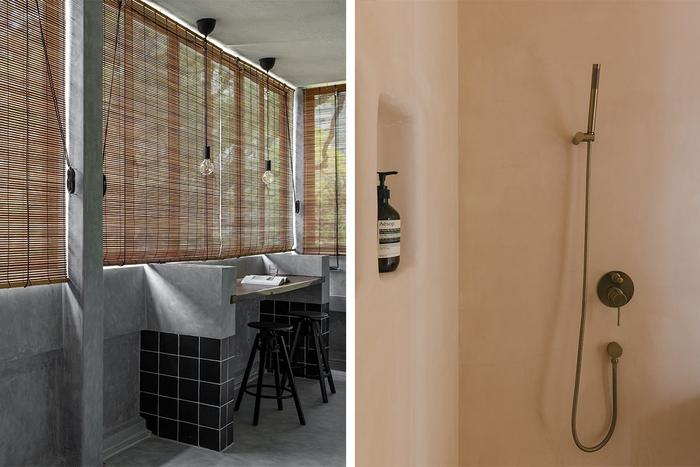What it is, how much it costs, and more facts about microcement from an interior designer.

Although you may have heard of it or even seen it in one of our home tours, microcement has grown in popularity over the years. And we totally get it – after all, it has many upsides, with the most prominent one being its ability to mimic the look and feel of real cement, sans maintenance woes like cracks and flaky surfaces.
Given the name, you may think it’s the same as cement screed – yet another popular material being used across homes in Singapore. But in reality, they are quite different, so before diving into the 101 on microcement, let us first examine the difference between these two materials.
What is the difference between microcement and cement screed?

View this project by Authors • Interior & Styling
Cement screed is a raw building material that combines concrete and sand (and then laid out over a concrete subfloor) whereas microcement is cement mixed with a variety of polymers.
While both microcement and cement screed flooring are both viable options, you should know that the former was created as a better, more durable alternative – without the cracking and fissures you’d get with cement screed.
Another difference lies in its application – while microcement has a total thickness of just 2-3mm, cement screed is much thicker. At 6cm and above, it makes them unsuitable for vertical surfaces like walls or ceilings, which means they are only able to be used for floors.

View this project by Authors • Interior & Styling
Now that you know the difference a little better, here's a proper breakdown on what makes microcement such a popular choice – which we've come up with with the help of Leven, an interior designer from Authors • Interior & Styling.
1. Microcement is a highly versatile material that can be applied to all kinds of surfaces

View this project by Authors • Interior & Styling
One of the biggest differences between microcement and regular cement is the greater versatility that the former possesses. Unlike cement, microcement can be applied to different types of surfaces including metal, tiles, and even on bricks.
“Based on my understanding, it’s because microcement is a more flexible mixture of regular cement as well as other components like polymers and pigments,” says Leven. “It’s also one of the reasons why I feel it’s increasing in popularity because it doesn’t function as yet another floor or wall covering and lets homeowners be more creative (with it).”
2. Compared to regular cement, microcement is less porous and more durable

View this project by Authors • Interior & Styling
While microcement is indeed porous, its surface is less permeable compared to regular cement, thus making it a more durable option for wet areas, like bathrooms or near a kitchen sink when applied properly. But nonetheless, be sure to avoid prolonged water exposure.
“You can use it for the walls in a bathroom, but the microcement suppliers don’t recommend using it in areas like the floor of a shower or any part of a house that has water pooling in it,” says Leven. “Aside from causing discolouration, water seepage can also cause bubbles to form beneath the microcement layer and that’s very hard to rectify.”
3. Grey isn’t the only colour that microcement comes in

Unlike their regular cement counterparts, microcement surfaces come in a range of colours, from (the typical) neutral greys to warm beige, and this is all thanks to pigments that are mixed in.
“It’s also easier to control the appearance of microcement finishes,” notes Leven. “Regular cement tends to give patchier-looking results with some sections appearing darker than others, but that isn’t the case with microcement, so I’d say it’s a better choice for homeowners who’re particular about aesthetics.”
4. It takes time for microcement to cure

View this project by Authors • Interior & Styling
According to Leven, it can be challenging for homeowners facing tight renovation deadlines to opt for microcement surfaces.
“From my experience working with a local microcement supplier and installer called Tsuri, there are about 5 to 6 separate layers of liquid and powdered resin which have to be applied to create a base and prime it, and it takes about 3 to 4 weeks for everything to dry, including the finishing and protective layers,” says Leven. “So, [the] bottomline is you can’t rush the process.”
5. Microcement tends to be pricier than cement (but can be more worth it)

Though microcement is usually 2 to 3 times the price of regular cement (which based on Leven’s estimations, typically costs $7 psf in Singapore to microcement’s $14 to $21 psf), it can still prove to be a worthwhile investment for any homeowner who wishes to achieve a worry-free ‘cement screed’ look.
“Personally, I think the cost [of microcement] can be quite steep, but it’s justified,” says Leven. “For instance, I believe the installers at Tsuri have to undergo a training course that teaches them the technical know-how [of installing microcement] and their microcement is sourced from Italy. That’s quite legit in my opinion. (laughs)”
This article was originally written on 15 November 2021, and last updated on 18 July 2023.
Yay, we're on Telegram! Follow us for the latest reno updates. 🙌
© Qanvast, 2021. No part of this site may be reproduced in whole or in part in any manner without permission.

 Get a budget estimate before meeting IDs
Get a budget estimate before meeting IDs